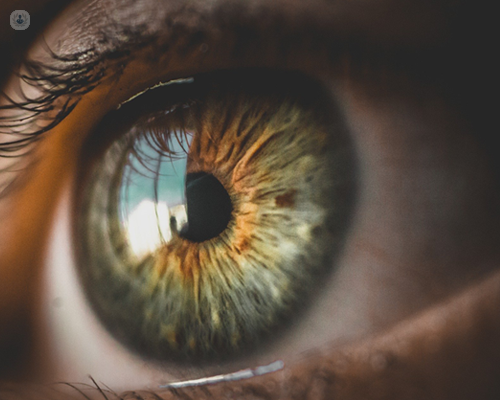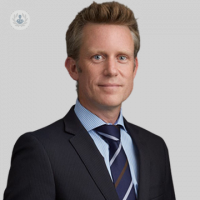All about selective laser trabeculoplasty (SLT)
Written in association with:Leading consultant ophthalmologist Mr Thomas Kersey takes a detailed look at selective laser trabeculoplasty, answering frequently asked questions about the procedure, in this informative article.

What is selective laser trabeculoplasty?
Selective laser trabeculoplasty (SLT) is a laser treatment used to reduce intraocular pressure (IOP) in patients with open angle glaucoma. Glaucoma is a condition that damages the optic nerve, often due to increased pressure within the eye. SLT is a minimally invasive procedure that targets specific cells in the trabecular meshwork of the eye, improving fluid drainage and lowering IOP.
How does SLT work?
SLT uses a low-energy laser to selectively target pigmented cells within the trabecular meshwork, the drainage system of the eye. The laser induces a biological response that remodels the trabecular meshwork, enhancing aqueous outflow and reducing IOP. The procedure is precise, affecting only the targeted cells without causing thermal damage to surrounding tissues.
Who is a candidate for SLT?
SLT is suitable for patients with open-angle glaucoma or ocular hypertension who require IOP reduction. It’s often considered when:
- Medications are insufficient to control IOP or cause significant side effects.
- Patients have difficulty adhering to medication regimens.
- Surgery is deemed premature or inappropriate.
What happens during the SLT procedure?
SLT is an outpatient procedure performed in an ophthalmologist's office. The steps involved are:
Numbing the eye
Anaesthetic eye drops are used to numb the eye, ensuring the patient is comfortable.
Applying a lens
A special contact lens is placed on the eye to focus the laser beam and hold the eyelids open.
Delivering the laser
The ophthalmologist delivers laser pulses to the trabecular meshwork. The procedure usually takes about 5 to 10 minutes per eye.
Post-procedure care
Anti-inflammatory eye drops may be prescribed to reduce any post-treatment inflammation.
What are the benefits of SLT?
SLT offers several benefits, including:
Non-invasive
It does not require incisions, stitches or general anaesthesia.
Safety
The procedure has a low risk of complications and minimal discomfort.
Effectiveness
SLT effectively reduces IOP in many patients, either as a primary treatment or in combination with other therapies.
Repetition
SLT can be safely repeated, if necessary, unlike some other laser treatments.
What are the risks and side effects of SLT?
While SLT is generally safe, some patients may experience temporary side effects, such as:
- Mild eye discomfort or redness
- Temporary increase in IOP
- Inflammation
- Blurred vision
These side effects are usually short-lived and resolve within a few days. Serious complications are rare, but it is important to follow up with your ophthalmologist to monitor IOP and eye health after the procedure.
How effective is SLT in managing glaucoma?
SLT is effective in lowering IOP in many patients, with success rates varying based on individual factors. It can reduce IOP by approximately 20-30 per cent, and the effects may last from several months to a few years. Some patients may require additional treatments or medications to maintain target IOP levels over time.
When should I consider SLT?
Patients with open-angle glaucoma or ocular hypertension should discuss SLT with their ophthalmologist if:
- Medications are not effectively controlling IOP.
- Medication side effects are intolerable.
- There are difficulties adhering to prescribed medication regimens.
SLT is a valuable option for managing open-angle glaucoma and ocular hypertension. It offers a safe, effective, and non-invasive means of reducing intraocular pressure, helping to preserve vision and prevent further optic nerve damage. Patients considering SLT should consult with their ophthalmologist to determine if it’s the right treatment option for their specific condition.
If you’re considering having a selective laser trabeculoplasty (SLT), arrange a consultation with Mr Kersey via his Top Doctors profile.


